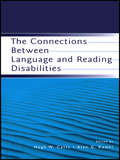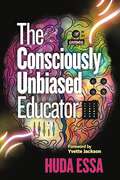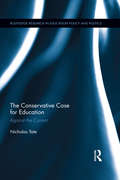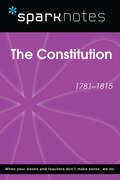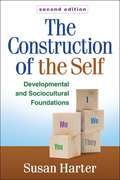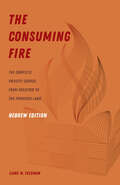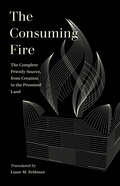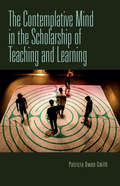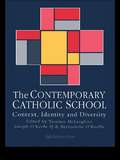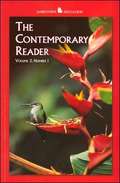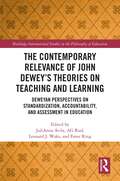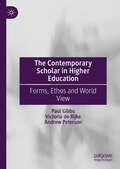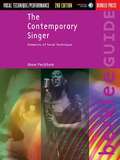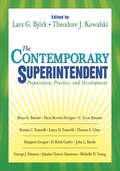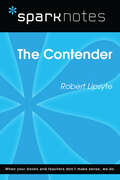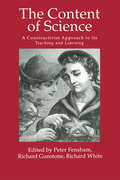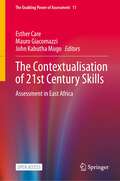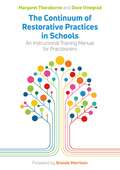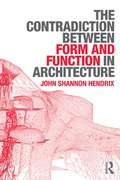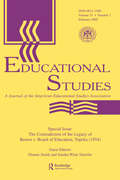- Table View
- List View
The Connections Between Language and Reading Disabilities
by Alan G. Kamhi Hugh W. CattsThis is an edited book based on papers presented at a 2003 invitee-only conference under the sponsorship of the Merrill Advanced Studies Center of the University of Kansas. The participants were prominent scholars in the areas of language and reading, and have research programs funded by NIH and other sources. The purpose of the gathering was to discuss theoretical issues and research findings concerning the relationship between developmental language and reading disabilities, specifically looking at neurological, behavioral, and genetic factors. In addition, it discussed other factors contributing to reading difficulties in the middle elementary school years through adolescence and literacy outcomes for children with early language impairments, and how these problems relate to children with dyslexia. The Foreword is written by Reid Lyon, Branch Chief, Child Development and Behavior Branch, NICHD-National Institutes of Health.This book appeals to scholars in the areas of language disorders and reading disabilities, as well as to practicing speech-language pathologists, special educators, and reading specialists. It may also be used in graduate courses designed as seminars in either language disorders or reading disabilities in schools of communication disorders, as well as schools of education--especially special education departments.
The Consciously Unbiased Educator
by Huda EssaEducators must achieve cultural proficiency to overcome unconscious biases and tap the limitless potential of their school communities. <p><p> In The Consciously Unbiased Educator, cultural proficiency expert and former teacher Huda Essa helps educators uncover and surmount the limitations of unconscious biases—stereotypes that form below the surface of our awareness, making them harder to detect. Although these biases aren't formed with the intent to do harm, if they are not interrupted, they contribute to negative outcomes for students. <p><p> With warmth and wisdom, Essa urges educators to move past any reflexive defensiveness or shame that comes with facing these biases to take a journey that will ultimately empower and benefit the entire school community. Filled with rich, clarifying insights drawn from Essa's own experience as well as comprehensive research findings, this inspirational resource pushes readers' thinking to new levels.
The Conservative Case for Education: Against the Current (Routledge Research in Education Policy and Politics)
by Nicholas TateThe Conservative Case for Education argues that educational thinking in English-speaking countries over the last fifty years has been massively influenced by a dominant liberal ideology based on unchallenged assumptions. Conservative voices pushing against the current of this ideology have been few, but powerful and drawn from across the political spectrum. The book shows how these twentieth-century voices remain highly relevant today, using them to make a conservative case for education. Written by a former government adviser and head teacher, the book focuses on four of the most powerful of these conservative voices: the poet and social critic T. S. Eliot, the philosopher Michael Oakeshott, the political thinker Hannah Arendt and the educationist E D Hirsch. In the case of each thinker, the book shows how their ideas throw fresh light on contemporary educational issues. These issues range widely across current educational practice and include: creativity, cultural literacy, mindfulness, the place of religion in schools, education for citizenship, the teaching of history and Classics, the authority of the teacher, the arguments for and against a national curriculum, the educational response to cultural diversity, and more. A concluding chapter sums up the conservative case for education in a set of Principles that would be acceptable to many from the Left, as well as the Right of the political spectrum. The book should be of particular interest to educators and educational policy makers at a time when ‘conservative’ governments are in power in the UK and the USA, as well as to researchers, academics and postgraduate students engaged in the study of educational policy, or those studying educational issues from an ethical, philosophical and cultural standpoint.
The Constitution (SparkNotes History Notes)
by SparkNotesThe Constitution (1781-1815) (SparkNotes History Note) Making the reading experience fun! SparkNotes History Guides help students strengthen their grasp of history by focusing on individual eras or episodes in U.S. or world history. Breaking history up into digestible lessons, the History Guides make it easier for students to see how events, figures, movements, and trends interrelate. SparkNotes History Guides are perfect for high school and college history classes, for students studying for History AP Test or SAT Subject Tests, and simply as general reference tools.Each note contains a general overview of historical context, a concise summary of events, lists of key people and terms, in-depth summary and analysis with timelines, study questions and suggested essay topics, and a 50-question review quiz.
The Constitution in Exile: How the Federal Government Has Seized Power by Rewriting the Supreme Law of the Land
by Andrew P. NapolitanoWhat ever happened to our inalienable rights?The Constitution was once the bedrock of our country, an unpretentious parchment that boldly established the God-given rights and freedoms of America. Today that parchment has been shred to ribbons, explains Fox News senior judicial analyst Judge Andrew P. Napolitano, as the federal government trounces state and individual rights and expands its reach far beyond what the Framers intended.An important follow-up to Judge Napolitano's best-selling Constitutional Chaos, this book shows with no-nonsense clarity how Congress has "purchased" regulations by bribing states and explains how the Supreme Court has devised historically inaccurate, logically inconsistent, and even laughable justifications to approve what Congress has done. It's an exciting excursion into the dark corners of the law, showing how do-gooders, busybodies, and control freaks in government disregard the limitations imposed upon Congress by the Constitution and enact laws, illegal and unnatural, in virtually every area of human endeavor. Praise for The Constitution in Exile from Left, Right, and Center"Does anyone understand the vision of America's founding fathers? The courts and Congress apparently don't have a clue. But Judge Andrew P. Napolitano does, and so will you, if you read The Constitution in Exile."-BILL O'REILLY"Whatever happened to states rights, limited government, and natural law? Judge Napolitano, in his own inimitable style, takes us on a fascinating tour of the destruction of constitutional government. If you want to know how the federal government got so big and fat, read this book. Agree or disagree, this book will make you think."-SEAN HANNITY"In all of the American media, Judge Andrew P. Napolitano is the most persistent, uncompromising guardian of both the letter and the spirit of the Constitution, very much including the Bill of Rights. Increasingly, our Constitution is in clear and present danger. Judge Napolitano--in The Constitution in Exile--has challenged all Americans across party lines to learn the extent of this constitutional crisis." -NAT HENTOFF"Judge Napolitano engages here in what I do every day on my program-make you think. There's no question that potential Supreme Court nominees and what our Constitution says and doesn't say played a major role for many voters in our last couple of elections. What the judge does here is detail why the federal government claims it can regulate as well as tax everything in sight as it grows and grows. Agree or disagree with him-you need to read his latest book, think, and begin to arm yourself as you enter this important debate." -RUSH LIMBAUGH"At a time when we are, in Benjamin Franklin's words, sacrificing essential liberty to purchase a little temporary safety, here comes the judge with what should be mandatory reading for the executive branch cronies who are busy stealing power while they think we're not watching. Thank goodness the judge is watching and speaking truth to power. More than a book, this is an emergency call to philosophical arms, one we must heed before it's too late." -ALAN COLMES
The Construction of Drawings and Movies: Models for Architectural Design and Analysis
by Thomas ForgetThe architectural imagery that you create is most effective when it examines your project in an abstract manner. Most students and practitioners understand linear perspective and cinema to be examples of architectural presentation tools. This book asks you to consider drawings and movies to be analytical tools that give you the capacity to engage all phases of the design process, from parti to presentation. The ways in which spaces relate to each other and how materials connect to each other in your projects are as important as your building’s appearance. As digital tools increasingly allow you to simulate the experience of built and unbuilt environments, it is essential that you scrutinize the nature of architectural imagery and resist the lure of virtual reality. Though pure simulation may be appropriate for your clients, your design process requires abstraction and analysis. Author Thomas Forget demonstrates how to construct analytical drawings and movies that challenge the alleged realism of linear perspective and cinema. These demonstrations expose you to underlying principles that will allow you to understand the broader implications of these methods. In addition, historical surveys of drawings and movies provide you with insight into how architects and architectural historians have understood the role of linear perspective and cinema in their fields. Finally, examples of drawing and moviemaking strategies illustrate how you can apply the lessons of the book to precedent analyses and design projects.
The Construction of the Self, Second Edition
by Susan Harter William M. BukowskiAn important work from a leading scholar, this book explores self-development from early childhood to adulthood. Susan Harter traces the normative stages that define the emergence of many self-processes, including self-esteem. She also addresses individual differences and societal influences on self-development. Presenting pioneering empirical research, Harter shows that increasingly mature features of the self have both benefits and liabilities for psychological adjustment. The book highlights the causes and consequences of different types of self-representations, including those that are unrealistically negative or positive. New to This Edition *Reflects more than a decade of conceptual, empirical, and methodological advances. *Provides a broader sociocultural framework for understanding self-development. *Chapters on emerging adulthood, self-esteem and physical appearance, self-processes in the classroom, motivation, cross-cultural issues, and the quest for authenticity. *Expanded chapters on childhood, adolescence, and the self-conscious emotions. *Increased attention to the liabilities of our contemporary preoccupation with the self.
The Consuming Fire, Hebrew Edition: The Complete Priestly Source, from Creation to the Promised Land (World Literature In Translation Ser.)
by Liane M. FeldmanEmbedded within the Bible lies a largely unknown story of the founding of early Israel and its religion, interwoven with tales documenting the creation of the Torah. Known as the Priestly Source, the complete text has not appeared on its own in either Hebrew or English—until now. This edition contains for the first time the full biblical Hebrew along with a new translation, annotated to guide readers through the text. This translation by Liane M. Feldman, an authority on the text, reveals the mythical foundation for the practice of sacrifice in ancient Israelite and Jewish religion. Beginning with the creation of the world and ending at the edge of the Promised Land, the Priestly Source offers a distinctive account from over two thousand years ago of the origins of the people of Israel and a unique perspective on their relationship with their god, Yahweh—one in stark contrast to what is found when we read the Bible now.
The Consuming Fire: The Complete Priestly Source, from Creation to the Promised Land (World Literature In Translation Ser.)
by Liane FeldmanUncovering an ancient foundation myth, and literary tour de force, obscured within the modern Bible. Embedded within the Bible lies a largely unknown story of the founding of ancient Israel and its religion, interwoven with other ancient tales nearly two thousand years ago in the process of creating the Torah. Generations of scholars have painstakingly worked to recreate the "Priestly Source," also known as "P." The complete text has not appeared until now on its own in either Hebrew or English. Beginning with the creation of the world and ending at the edge of the promised land, the Priestly Source offers a distinctive account of the origins of the people of Israel and a unique perspective on their relationship with their god, Yahweh—one in stark contrast to what is found when we read the Bible now. With a translation by Liane Feldman, an authority on the text, The Consuming Fire reveals the mythical foundation for the practice of sacrifice in ancient Israelite and Jewish religion. By presenting this fascinating material on its own, The Consuming Fire offers an opportunity to expand our understanding of ancient traditions and to find something new and beautiful at the source.
The Contemplative Mind in the Scholarship of Teaching and Learning
by Patricia Owen-SmithIn The Contemplative Mind in the Scholarship of Teaching and Learning, Patricia Owen-Smith considers how contemplative practices may find a place in higher education. By creating a bridge between contemplative practices and the Scholarship of Teaching and Learning (SoTL), Owen-Smith brings awareness of contemplative pedagogy to a larger audience of college instructors, while also offering classroom models and outlining the ongoing challenges of both defining these practices and assessing their impact in education. Ultimately, Owen-Smith asserts that such practices have the potential to deepen a student’s development and understanding of the self as a learner, knower, and citizen of the world.
The Contemplative Practitioner
by John P. MillerMeditation is a simple and practical activity that can enrich our lives and work in innumerable ways. It allows us to connect more deeply to ourselves and others and to the environment. In this book, John P. Miller, an expert in the field of holistic education, looks at mediation and how it can be integrated into one's work and daily life.Twenty years after it was first published, Miller's book remains one of the best guides to applying contemplative practice, covering a variety of theoretical, empirical, historical, and cross-cultural approaches. For this new edition, Miller has updated the text to reflect the growth of the mindfulness movement, new research into the brain, and his years of experience teaching and practising contemplation in teacher education.Whether one is interested in exploring how meditation can be used in the classroom or the workplace, or simply seeking to integrate it into one's personal life, The Contemplative Practitioner is the perfect companion.
The Contemporary Catholic School: Context, Identity And Diversity
by Terence McLaughlin Joseph O'Keefe Sj Bernadette O'KeefeFirst published in 2004. Routledge is an imprint of Taylor & Francis, an informa company.
The Contemporary Reader
by Jamestown Education StaffThe Contemporary Reader contains captivating nonfiction to engage low-level readers while building important reading comprehension skills and vocabulary.
The Contemporary Relevance of John Dewey’s Theories on Teaching and Learning: Deweyan Perspectives on Standardization, Accountability, and Assessment in Education (Routledge International Studies in the Philosophy of Education)
by JuliAnna ÁvilaThrough expert analysis, this text proves that John Dewey’s views on efficiency in education are as relevant as ever. By exploring Deweyan theories of teaching and learning, the volume illustrates how they can aid educators in navigating the theoretical and practical implications of accountability, standardization, and assessment. The Contemporary Relevance of John Dewey’s Theories on Teaching and Learning deconstructs issues regarding accountability mechanisms, uniform assessment systems, and standardization processes through a Deweyan lens. Connecting the zeitgeist of the era from which Dewey’s ideas emerged and current global political, social, and economic contexts, the book emphasizes the importance of resilient systems in reconciliating the tension between standardized assessments and individual student development. Contributors provide insights from a range of settings across Pre-K, primary, secondary, and higher education and address topics including teacher agency, voice, leadership, and democracy. The volume will be of interest to scholars, researchers, and academics with an interest in philosophy of education, education policy and the impact of neoliberal agendas, as well as teaching and learning more broadly.
The Contemporary Relevance of John Dewey’s Theories on Teaching and Learning: Deweyan Perspectives on Standardization, Accountability, and Assessment in Education (Routledge International Studies in the Philosophy of Education)
by JuliAnna ÁvilaThrough expert analysis, this text proves that John Dewey’s views on efficiency in education are as relevant as ever. By exploring Deweyan theories of teaching and learning, the volume illustrates how they can aid educators in navigating the theoretical and practical implications of accountability, standardization, and assessment. The Contemporary Relevance of John Dewey’s Theories on Teaching and Learning deconstructs issues regarding accountability mechanisms, uniform assessment systems, and standardization processes through a Deweyan lens. Connecting the zeitgeist of the era from which Dewey’s ideas emerged and current global political, social, and economic contexts, the book emphasizes the importance of resilient systems in reconciliating the tension between standardized assessments and individual student development. Contributors provide insights from a range of settings across Pre-K, primary, secondary, and higher education and address topics including teacher agency, voice, leadership, and democracy.The volume will be of interest to scholars, researchers, and academics with an interest in philosophy of education, education policy and the impact of neoliberal agendas, as well as teaching and learning more broadly.
The Contemporary Scholar in Higher Education: Forms, Ethos and World View
by Andrew Peterson Paul Gibbs Victoria De RijkeThis book examines what a scholar looks and feels like in contemporary times. It suggests that scholars are more than people employed as academics and discusses how different world ideologies, cultures and systems view their scholars and how they might be considered in the changing and challenging nature of higher education. The book includes discussion from Islamic, Confucian, postcolonial and post-Soviet perspectives, alongside other approaches such as the scholar-artist, thinker, teacher and activist. It will appeal to students and scholars working in the philosophy of higher education, higher education practice and comparative studies.
The Contemporary Singer: Elements of Vocal Technique (Second Edition)
by Anne PeckhamThe second edition of this bestselling, comprehensive guide contains improved vocal workouts and additional topics, including performance anxiety and healthy singing. Topics covered include getting started, posture, belting and diction, maintaining vocal health, microphone technique, and much more.
The Contemporary Superintendent: Preparation, Practice, and Development
by Dr Theodore J. Kowalski Lars G. BjorkA strong superintendent is critical to the success of an entire school district, and this exciting new resource details the issues surrounding the state policies that appoint superintendents.
The Contender (SparkNotes Literature Guide Series)
by SparkNotesThe Contender (SparkNotes Literature Guide) by Robert Lipsyte Making the reading experience fun! Created by Harvard students for students everywhere, SparkNotes is a new breed of study guide: smarter, better, faster.Geared to what today's students need to know, SparkNotes provides:chapter-by-chapter analysis explanations of key themes, motifs, and symbols a review quiz and essay topics Lively and accessible, these guides are perfect for late-night studying and writing papers.
The Content Of Science: A Constructive Approach To Its Teaching And Learning
by Richard T. White Peter J. Fensham Richard F. GunstoneFirst published in 1994. Leading scholars in science education from eight countries on four continents and ex-pert practising science teachers (primary and secondary) wrote about the teaching and learning of particular science content or skills, and hence how different science content requires different sorts of teaching and learning. Having shared the papers, they then met to discuss them and subsequently revised them. The result is a coherent set of chapters that share valuable insights about the teaching and learning of science. Some chapters consider the detail of specific topics (e.g. floating and sinking, soil and chemical change), some describe innovative procedures, others provide powerful theory. Together they provide a comprehensive analysis of constructivist learning and teaching implications.
The Contextualisation of 21st Century Skills: Assessment in East Africa (The Enabling Power of Assessment #11)
by Esther Care Mauro Giacomazzi John Kabutha MugoThis open access book is written for educators and policymakers who seek to empower young people with competencies necessary for fulfilling lives in the 21st century. It reports how a large group of educators from government and civil society organisations, together with researchers from universities, used their curriculum, assessment, and social economy expertise to develop contextualised definitions of life skills and values, and associated assessment tools. The book also reports on levels of these competencies of over 45,000 adolescents, from a household-based assessment conducted in Kenya, Tanzania, and Uganda. The results describe how these adolescents vary in proficiency by region, age, and other factors, providing a resource for national education ministries to factor into policy decisions. Given the technical requirements of measuring individuals’ social-emotional and related competencies, how is it possible to capture an adolescent’s life skills across varied contexts? The book provides readers with a pragmatic yet technically robust process for undertaking a large-scale assessment program designed to inform policy.
The Continuum of Restorative Practices in Schools: An Instructional Training Manual for Practitioners
by Margaret Thorsborne Dave VinegradAn instructional manual on restorative justice in schools from world-leading experts; this 'how to' guide offers guidance on the issues of carrying out restorative practices, including coping with day-to-day problems, and offers worksheets for practical daily use.Beginning with challenges to orthodox thinking about behaviour change, it goes on to describe a multitude of approaches to respond to minor incidents in school settings, then takes a close look at using restorative approaches to bullying, before it finally focuses on the formal end of the continuum (including conference preparation and facilitation). This book is reflective of the evolution of processes and responses from the most serious of incidents through to minor everyday issues, making this an essential resource for all school staff.
The Contradiction Between Form and Function in Architecture
by John Shannon HendrixContinuing the themes that have been addressed in The Humanities in Architectural Design and The Cultural Role of Architecture, this book illustrates the important role that a contradiction between form and function plays in compositional strategies in architecture. The contradiction between form and function is seen as a device for poetic expression, for the expression of ideas, in architecture. Here the role of the terms "form" and "function" are analyzed throughout the history of architecture and architectural theory, from Vitruvius to the present, with particular emphasis on twentieth-century functionalism. Historical examples are given from Ancient, Classical, Islamic, Christian, Byzantine, Gothic, Renaissance, Mannerist, and Neoclassical architecture, and from movements in the twentieth century to the present. In addition philosophical issues such as lineamenti, Vorstellung, différance, dream construction, deep structure and surface structure, topology theory, self-generation, and immanence are explored in relation to the compositions and writings of architects throughout history. This book contributes to the project of re-establishing architecture as a humanistic discipline, to re-establish an emphasis on the expression of ideas, and on the ethical role of architecture to engage the intellect of the observer and to represent human identity.
The Contradictions of the Legacy of Brown V. Board of Education, Topeka (1954): A Special Issue of Educational Studies
by Dianne Smith Sandra Winn TutwilerOn May 17, 1954, the Supreme Court ruled that separate school facilities were inherently unequal and thus unconstitutional and illegal. Today, 50 years after this landmark decision, much debate surrounds the efficacy of the ruling, particularly for its impact on the education of children of color in U.S. schools. In reality, Brown v. Board of Education of Topeka, Kansas, was never solely about education; neither did the case include only plaintiffs from Topeka. Both points are important to note as we reflect on the legacy of Brown a half century after the ruling. This journal offers articles, an interview, book reviews and a media review around this area.
The Contribution of Mathematics to School STEM Education: Current Understandings
by Katie Makar Judy AndersonThis book presents contemporary STEM education research conducted by mathematics education researchers and their collaborators which highlights the important and pivotal role of mathematics in school STEM education. It showcases evidence of the types of integrated curriculum approaches to STEM education which highlight mathematics as a key component and where mathematical concepts can be learnt through integrated tasks. These examples challenge the idea that mathematics is just an application or ‘servant’ to the other STEM subjects and highlight the contribution that mathematics can make to the understanding and practices of the other STEM subjects. This book fills a void in the current research literature on the role of mathematics in STEM education, provides evidence of the possibilities for designing integrated STEM curriculum and highlights current understandings of the role of mathematics in school STEM education. For researchers, it identifies and elaborates gaps to encourage further exploration in this field.
